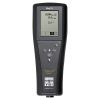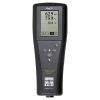YSI Pro2030 Dissolved Oxygen & Conductivity Meter
The YSI Pro2030 is a handheld dissolved oxygen meter (sensors sold separately) that automatically compensates for changes in salinity values.
Features
- Internal barometer for high accuracy dissolved oxygen readings
- Choose from a long life polarographic sensor or immediate warm-up galvanic sensor (sensors sold separately)
- Quick Cal allows DO calibrations within seconds at the push of a button
- Free ground shipping
- Expedited repair and warranty service
- Lifetime technical support
- More
Overview
The YSI Pro 2030 is a handheld dissolved oxygen & conductivity meter that can simultaneously measure dissolved oxygen, salinity, conductivity, specific conductance, total dissolved solids (TDS), barometric pressure and temperature.
Long-Lasting and Quick Response
Offer fast response times with polarographic or galvanic DO sensor options. The long life of the polarographic sensor saves time and money, reducing overall cost. The galvanic sensor allows the user to start sampling immediately without a warm-up period. Both sensors offer accurate, quality data. The stable 4-electrode conductivity cell is built into the cable and will provide years of accurate data. The cells are designed for rugged field performance, are easily cleaned and require minimal maintenance.
Meets the Demands of True Field Work.
Rated to IP-67 standards even without the battery cover on. Other tough features include Mil-spec connectors and rubber over-molded case. In-house testing procedures also include 1m drop tests from all angles to ensure expected field-durability.
Additional Features Include:
- Choose field DO sensors (Polarographic or Galvanic)
- Stores 50 data sets
- Graphic, backlit display and glow-in-the-dark keypad
- Available with 1, 4, 10, 20, or 30m cables (4m and longer cables include cable management kit)
- View display with polarized sunglasses on
- Fastest DO response time on the market with 95% response in 8 seconds with standard membrane
- Multiple languages include English, Spanish, French and German
- User replaceable DO sensors and cables
- Conductivity cell built-in
- 3-year instrument; 2-year cable warranty
*YSI Pro2030 purchases include the instrument, manual, batteries, USB cable, and USB flash drive. Cables and probes are ordered separately.
- Barometer: Built-in barometer
- Cable Lengths: 1- 4- 10- 20- and 30-m lengths (3.28, 13.1, 32.8, 65.6 ft.)
- Certifications: RoHS, CE, WEEE, IP-67, 1-meter drop test
- Connector: MS (military spec) waterproof with bayonet lock
- Data Memory: 50 data sets
- Dimensions: 8.3 cm width x 21.6 cm length x 5.6 cm depth (3.25 in x 8.5 in x 2.21 in)
- Languages: English, Spanish, German, French
- Power: 2 alkaline C-cells providing approximately 400 hours of battery life depending on backlight usage; low battery indicator
- Salinity Input Range: 0-70 ppt; automatic - uses conductivity reading; DO compensated for salinity values
- Warranty: 3-year instrument; 2-year cable; 1-year Polarographic sensors; 6-months Galvanic sensors
- Waterproof: IP-67 (even with the battery cover off)
- Weight with Batteries: 475 grams (1.05 lbs)
- Conductivity Reference Temp: Adjustable; range 15C to 25C
- Specific Conductance Temp Comp: 0 to 4%
- (1) YSI Pro2030 display
- (1) Operations manual
- (2) C-cell batteries
In The News
Restoring Brook Trout Stream Habitat
Migrating fish species have it tough when it comes to getting back to their spawning grounds. Most of the time, they’re swimming against high-velocity currents and have to worry about passing through culverts and dams. But with the right mix of restoration projects, it’s possible to make things easier for these fish, as officials with the U.S. Fish and Wildlife Service (USFWS) know quite well. Crews with the agency in New York have been focusing in recent months on projects that can help brook trout, a fish that is held in high regard by anglers in the state. Before restoration work can take place, it’s important to know what streams, if improved, will provide the most benefits for brook trout.
Read MoreResearchers pioneer continuous groundwater quality monitoring in Ontario
As a graduate student in Ontario, Jana Levison manually sampled groundwater wells in a hay field for a week straight. Now an assistant professor in the University of Guelph's School of Engineering, Levison is investigating how a new generation of water quality sensors can move the science forward while cutting the labor back. Levison said her doctoral work in a crystalline bedrock aquifer showed monthly variations in nitrate — a common groundwater contaminant often sourced to intensive agriculture — and daily variations in E. coli. Those short-term changes got her interested in watching groundwater in a more detailed manner. "Now we have the equipment that we can do that," Levison said. That equipment includes YSI's EXO multi-parameter sondes and Satlantic's SUNA nitrate sensor.
Read MoreData buoy on Acadia National Park's Jordan Pond to help answer clarity questions
Acadia National Park, the oldest national park east of the Mississippi, sits off Maine's Atlantic coast and covers most of Mount Desert Island — an unlikely name for a landmass covered in lakes and ponds. One of those is Jordan Pond, the deepest on the island, which is a famously clear lake in a state famous for clear lakes. "Jordan Pond is historically one of the most transparent lakes in Maine--or at least that's what they claim," said Nora Theodore, a masters student in ecology and environmental science at the University of Maine. And though the lake remains incredibly clear, decades of monitoring show the clarity is trending downward. "It's an extremely low productivity system, but that's been changing," she said. Transparency in Jordan Pond has been in decline since the 1990s.
Read More





































